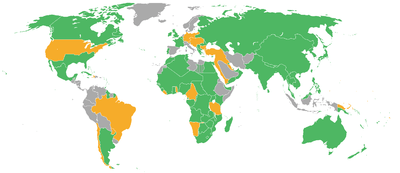Great War (series)
| Great War | |||||
|---|---|---|---|---|---|
| Part of Southern Victory Series | |||||
 The Entente Powers depicted in green, the Central Powers are in orange, and neutral countries are in grey. | |||||
| |||||
| Belligerents | |||||
|
Entente Powers: |
| ||||
| Commanders and leaders | |||||
|
|
| ||||
Great War is an alternate history trilogy by Harry Turtledove, which follows How Few Remain. It is part of Turtledove's Southern Victory Series series of novels. It takes the Southern Victory Series Earth from 1914 to 1917.
The Great War saga
Smarting from two defeats at the hands of the Confederate States of America, which was allied with the United Kingdom and France, the United States of America has turned to an alliance with the strengthening German Empire as well as Austria Hungary, and The Ottoman Empire. The US military has been reformed along German lines, and gets a great deal of technical assistance from Germany, especially with regard to fighter aircraft. The antebellum Republican Party has mostly collapsed, discredited by the defeats, leaving the right-winged Democratic Party and the left-winged Socialist Party (whose rise was aided by the defection of former President Abraham Lincoln and his supporters from the Republicans to the Socialists) as the main political parties in the United States.
When in 1914 the Great War breaks out in Europe following the Assassination of Archduke Franz Ferdinand of Austria and his wife Sophie by car bombing, both the USA and CSA join almost immediately on the side of their respective allies, and the USA is fighting a two-front war against Britain's primary representative on North America, Canada and Newfoundland to the north, and the Confederate States to the south. In eastern North America, the conflict soon bogs down into trench warfare, while in the West the battle lines are more fluid. Various characters are traced through the war, with several male characters changed forever by their military service. In South America, Chile went to war with Argentina.
In this series, the war remains known as "The Great War" and the term "World War" never comes into use. When a second war of comparable proportions breaks out twenty years later, it get named "The Second Great War" and the earlier one becomes retroactively "The First Great War".
Novels
- The Great War: American Front (1997)
- The Great War: Walk in Hell (1998)
- The Great War: Breakthroughs (1999)
Southern Victory Series
The Great War trilogy is followed by the American Empire trilogy and Settling Accounts tetralogy. It is preceded by his novel How Few Remain.